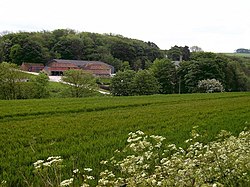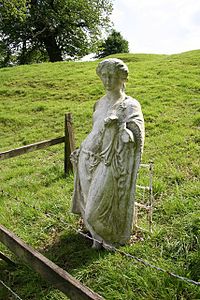North Ormsby
- Not to be confused with North Ormesby
| North Ormsby | |
| Lincolnshire | |
|---|---|
 North Ormsby | |
| Location | |
| Grid reference: | TF288934 |
| Location: | 53°25’19"N, 0°3’44"W |
| Data | |
| Population: | 134 (2011) |
| Post town: | Louth |
| Postcode: | LN11 |
| Local Government | |
| Council: | East Lindsey |
| Parliamentary constituency: |
Louth and Horncastle |
North Ormsby is a village in Lindsey, the northern part of Lincolnshire. It is found about seven miles north-west of the nearest market town, Louth.
History
North Ormsby was in antiquity known as Nun Ormsby.[1] It is documented in the Domesday Book of 1086 as "Ormesbi".[2] The manor comprised 1 smallholder, 10 freemen, 8 ploughlands, 40 acres of meadow and 10 acres of woodland. Lords in 1066 were Skemundr and Ulf Fenman, the land transferred to Geoffrey of Aalst as lord of the manor in 1086 with Drogo of la BeuvriËre as Tenant-in-chief.[3]
A Gilbertine priory dedicated to St Mary was founded as a double house between 1148 and 1154, and dissolved in 1538. There are still earthworks visible, and the site is a scheduled ancient monument.[4]
Church
The former parish church, St Helen, was built in 1848 by S. S. Teulon. and is a Grade II listed building. It was declared redundant in 1980 by the Diocese of Lincoln and sold for private residential use.[5][6]
Within the church is a railed monument surmounted by an urn, a memorial to Mary Russell (d.1855).[6] Pevsner however, assigns the tomb to John Ansell (d.1797) and his wife (d.1808), and describes it as "an exceptional piece".[7]
In 1863 six graves cut from chalk and dressed with sandstone were found in the churchyard, and were probably of Anglo-Saxon date.[8] There is also a Grade II listed cross in the churchyard, dating from the 14th century.[9]
Sights of the village

"The White Lady of North Ormsby" is a life-size statue which now stands in the grounds of Abbey Farm. It depicts a lady in Grecian style and was erected here in 1850 to commemorate the death of a lady in a riding accident.[10] In 1964 Pevsner reported the White Lady's position as just south of Ormsby Abbey, a Victorian house.[7] The statue is Grade II listed..
Near Mill Farm is the site of a First World War military airfield established in 1917 and abandoned in 1919. It was intended for No. 33 Squadron RAF use as an emergency landing site for aircraft if short of fuel during anti-Zeppelin operations.[11]
Outside links
| ("Wikimedia Commons" has material about North Ormsby) |
References
- ↑ A History of the County of Lincoln - Volume pp @: North Ormsby (Victoria County History) – [http://www.british-history.ac.uk/report.aspx?compid=38035 British History Online}}
- ↑ "Documents Online: North Ormsby", Folio: 351r, Great Domesday Book; The National Archives. Retrieved 16 December 2011
- ↑ Ormsby North Ormsby in the Domesday Book
- ↑ National Heritage List 1010706: Gilbertine Priory, North Ormsby (Scheduled ancient monument entry)
- ↑ Information on North Ormsby from GENUKI
- ↑ 6.0 6.1 National Heritage List 1168222: St Helen, North Ormsby (Grade II listing)
- ↑ 7.0 7.1 Nikolaus Pevsner: The Buildings of England: Lincolnshire, 1964; 1989 Penguin Books ISBN 978-0-300-09620-0page 327
- ↑ Cox, J. Charles (1916) Lincolnshire p. 239; Methuen & Co. Ltd.
- ↑ National Heritage List 1063145: Churchyard Cross, North Ormsby (Grade II listing)
- ↑ National Heritage List 1063144: Statue near Abbey Farm
- ↑ National Monuments Record: No. 1399678 – Mill Farm Landing Ground
